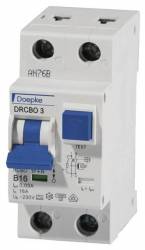Doepke DRCBO 3 B16/0,03/1N-A KV - DRCBO 3 B16 / 0 03 / 1N A KV FI / LS combination 09 932 404
Installation > Modular devices / equipment installation > Circuit breaker

Doepke DRCBO 3 B16/0,03/1N-A KV - DRCBO 3 B16 / 0 03 / 1N A KV FI / LS combination 09 932 404
| Lieske Part No. | 997599 |
|---|---|
| Mfg Part No | 09932404 |
| EAN-Code | 4014712220928 |
| Manufacturer | Doepke |
| Here only | 122,86 EUR
146,20 EUR incl. VAT
|
Further information for Doepke DRCBO 3 B16/0,03/1N-A KV - DRCBO 3 B16 / 0 03 / 1N A KV FI / LS combination 09 932 404
RCBOs combine residual current and circuit breakers in one device (FI/LS combination). They protect people from residual currents and systems from short circuits and overloads. The switches in the DRCBO 3 series work independently of the mains voltage and are characterized by a high rated switching capacity. Separate displays provide a quick overview of the current operating status. DRCBO 3s can be easily installed and removed. Type A switches are sensitive to pulse and alternating current. This function is independent of the mains voltage. Switches with tripping characteristic B are the standard protection for light and socket circuits. KV-design switches have a response delay and are therefore considerably less sensitive to short-term pulse-shaped residual currents. They thus increase system availability. They can generally be used instead of a standard switch, as their protective function is completely retained. Properties: tripping independent of auxiliary voltage, sensitive for alternating and pulsating direct residual currents (type A), small size for all rated currents, high short-circuit strength, green-red contact position indicator, residual current trip indicator, clamping yoke terminals with rear plug protection and wide clamping cross-section range for rail and cable wiring on both connection sides, neutral conductor on the right, tristable locking slides for easy installation and removal, mounting type: quick attachment to mounting rail, installation position as desired, feed-in as desired, areas of application: protection of circuits in residential and commercial buildings as well as industrial plants with TN-S, TT and TN-CS networks. In IT networks, FI/LS switches can be provided for shutdown in the event of a second earth fault. Use in systems with TN-C networks and for protecting circuits in which power electronics equipment can cause smooth direct residual currents or residual currents with frequencies other than 50/60 Hz is excluded.

This is an offer of:
79279 Vörstetten
http://industry-electronics.com
Tel. 07666/88499-0
Fax. 07666/88499-111
Diesen Artikel finden Sie unter:
industry-electronics.com/artikel/997599

Lieske Elektronik e.K.
Reutener Str. 1079279 Vörstetten
http://industry-electronics.com
Tel. 07666/88499-0
Fax. 07666/88499-111
Diesen Artikel finden Sie unter:
industry-electronics.com/artikel/997599
